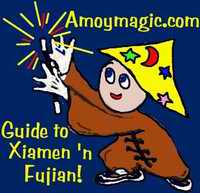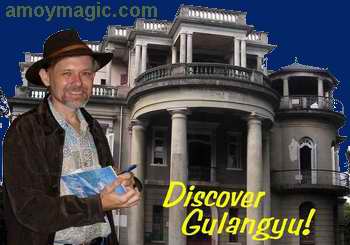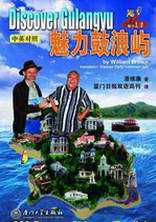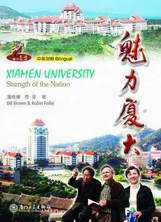![]() Click
to
Access
Click
to
Access
OUTSIDE China
![]() Click
to Access
Click
to Access
INSIDE
China ![]()
TRAVEL LINKS
![]() Xiamen
Xiamen
![]() Gulangyu
Gulangyu
![]() Jimei
Jimei
![]() Tong'an
Tong'an
![]() Jinmen
Jinmen
![]() Zhangzhou
Zhangzhou
![]() Quanzhou
Quanzhou
![]() Wuyi
Wuyi
![]() #1Fujian
Sites!
#1Fujian
Sites!
![]() Fujian
Foto Album
Fujian
Foto Album
![]() Books
on Fujian
Books
on Fujian
![]() Readers'Letters
Readers'Letters
![]() Ningde
Ningde
![]() Zhouning
Zhouning
![]() Longyan
Longyan
![]() Sanming
Sanming
![]() Putian
Putian
![]() Bridges
Bridges
![]() Travel
Info,
Travel
Info,
![]() Hakka
Roundhouses
Hakka
Roundhouses
![]() Travel
Agents
Travel
Agents
MISC. LINKS
![]() Amoy
People!
Amoy
People! ![]()
![]() Darwin
Driving
Darwin
Driving ![]()
![]() Amoy
Tigers
Amoy
Tigers
![]() Chinese
Inventions
Chinese
Inventions
![]() Tibet
in 80 Days!
Tibet
in 80 Days!![]()
![]() Dethroned!
Dethroned!
![]()
![]() Misc.Writings
Misc.Writings
![]() Latest
News
Latest
News
![]() Lord
of Opium
Lord
of Opium
![]() Back
to Main Page
Back
to Main Page
![]() Order
Books
Order
Books![]() Xiamenguide
Forum
Xiamenguide
Forum 

Discover
Gulangyu! Guide to Gulangyu
Click for Gulangyu
MAIN PAGEr
Click
for "Gulangyu At a Glance"
Click for "Gulangyu Tour
Themes" Click for "Getting
to Gulangyu"
Click for "Supplement--Popular
Port of Call"
Chapter
1 Exotic  Gulangyu
Islet (excerpts)
Gulangyu
Islet (excerpts)
Something for Everyone!
“To the rare foreign visitor, Gulangyu is astonishingly
reminiscent of an amalgam of other places far away:
“Old
Havana (which I know only from pictures, but its crumbling mansions seem
very similar to Gulangyu's).
“A Mexican hill town, such as Taxco or San Miguel,
even down to the tiled streets in some cases.
“The Cinque Terre of Italy--beautiful, balmy, quiet.
“Hawaii, with its wild poinsettias, bougainvillea, pleasant beaches.
“An Austrian village, with piano and violin music wafting from open
windows.
“A little bit of Las Vegas, with gaudy lights every evening on every
imaginable landmark on both sides of the channel.
“Put this all in a Chinese setting, and you have Gulangyu.”
Brian Dearle (www.newcolonist.com)
Xiamen is China’s “Garden Island” but
her Crown Jewel is Gulangyu (“Drum Wave Islet”), the elegant
1.78 square kilometer haven just 700 meters across Xiamen Harbor. Settled
during the Yuan Dynasty (1271-1368), Gulan-gyu was named Yuan Shazhou
(“round sandy island”) during the Ming Dynasty (1368-1644),
but a geological mystery gave rise to its present name…
Ancient settlers were unsettled by eerie drum beats emanating from the
clearly uninhabited island, but eventually discovered the ghostly drumming
was caused by tides surging through a hollow rock on the island’s
southwest corner. Relieved that “Round Sandy Island” wasn’t
haunted, or a lair for cannibal tribes from across the Strait, they renamed
their new home “Drum Wave Islet” (Gulangyu). 
While Stone Drum is silent nowadays, the islet drums up plenty of tourism
because of its lush tropical gardens, rich musical and cultural heritage,
and its unparalleled panoply of international colonial-era architecture.
Gulangyu’s serpentine lanes wind past high-walled
gardens on lushly shaded hills, and hundreds of aged but elegant mansions
built during the heyday of the early 20th century. As you savor the scenery
and sleepy silence, you can almost imagine the opulence of yesteryear,
when this drowsy islet teemed with the International Settlement’s
turbaned Gurkha policemen, dignitaries of a dozen nations, and wealthy
Chinese and Western businessmen borne upon ornate sedan chairs by attendants
in uniforms emblazoned with pampered employers’ mono-grams.
In 1920, Hutchinson wrote that Gulangyu had more wealthy people than anywhere
on earth except Pasadena, California! The wealth is gone, but the rich
international heritage remains.
Back to top
1. Area:
1.87 km2
2. Population: 15,000 (minus 2; Bill & Kitty Job
moved off-island)
3. Language: Mandarin, Minnan (S. Fujian) Dialect
4. Location: 118 degrees East, 24 degrees North, and
just S.E. of Xiamen
5. Climate: sub-tropic maritime monsoon, warm year-round
with 20.9 C average temperature, high of 35 C, low of 5 C.
6. Nicknames: Garden on the Sea, Piano Island, Isle of
Music,
Museum of International Architecture
7. Unique customs: Dragon Boat Festival duck catching,
Mooncake Game, family music recitals, weekend philharmonic symphonies
8. Culinary Treats: Mooncakes (China’s best!),
prepared meats (from a shop opened in 1842!), Minnan cuisine, seafood,
light soups, crispy friend dishes, fish balls, zongzis, green bean pie,
coconut pie, etc.
9. Main Attractions:
Sunlight Rock (Koxinga Memorial, Ancient Fort, Cable
Car)
Historic International Architecture (hundreds of elegant
buildings)
Shuzhuang Garden (and Piano Museum)
Hero Hill: Tingtao Bluff, Hero Garden, Gulangyu Aviary
Gulangyu Music Hall (frequent concerts), Xiamen Music
Academy
Bright Moon Garden (Koxinga Statue)
Xiamen Museum (and Organ Museum)
Gangzihou Beach, Drum-Wave Rock, Yindou Rock
Xiamen Sea World (behind the giant octopus sculpture
by the ferry)
10. Shopping—stock up on local specialties like
Gulangyu pearls, pre-pared foods and mooncakes, as well as Anxi tea, Zhangzhou
hand puppets, Hui’an stone carvings, Fuzhou’s Shoushan stone—and
Mr. Bai Hua’s inimitable Gulangyu postcards.
Historical Tour Koxinga made China’s last stand for the Ming Dynasty, here on Gulangyu, and from here sailed off to rescue Taiwan from the Dutch. And a century ago this tiny islet’s an international settlement was host to the planet’s most powerful trading firms and consulates of 13 countries. Gulangyu and Xiamen were also the “Birthplace of Chinese Protestantism.” with China’s oldest Protestant churches.
Pioneering Medicine and Education Tour Known as “The Cradle of Tropical Medicine”, Gulangyu was pivotal in developing both Chinese and Western modern medicine. The islet was also home to many pioneer educators (especially in women’s education), and boasted over 20 institutes of learning.
Music & Arts Tour The “Isle of Music,” or “Piano Island,” has more pi-anos per capita than any other city in China, Asia’s largest piano museum, and has produced dozens of famous musicians, including world-renowned pianist Yin Chengzong, and acclaimed conductor Madame Zheng Xiaoying. The islet was also home to the famous writer Lin Yutang and artist Teng Hiok Chiu.
Architectural Tour In 2001 alone, Gulangyu spent 7.5 million USD pro-tecting hundreds of historic buildings in this “World Museum of Architecture.”
Garden Tour China’s 1st ISO-authenticated administrative district, Gulan-gyu spent 120 million USD relocating enterprises off-island to preserve this bo-tanical paradise. Key parks include:
Shuzhuang Garden
(Shuzhuang Huayuan), Gulangyu’s largest garden includes the Piano
Museum (Gangqin Bowuguan).
Gulangyu Aviary (Bainiao Yuan)
Bright Moon Garden (Haoyue Yuan) & Koxinga Statue.
Yanping Park (Yanping Gongyuan): miraculous Koxinga Well.
Subtropical Botanical Garden
Private Gardens—many historic private villas have delightful gardens.
Shopping & Entertainment Tour Gulangyu is a shopper’s and diner’s paradise, with value-priced Fujian handicrafts, specialties, antiques, fine foods and teas, etc. You’ll shop till you drop—or until your wallet is empty. (The best shopping is straight ahead of the ferry on Longtou Rd.) Enjoy the Minnan Tea Ceremony, the famous Mid-Autumn Mooncake game, and attractions like Xia-men Underwater World, the Cable Cars, and the beaches.
Peace
& Quiet Savor the silence—Gulangyu has no cars
or bikes (though you may see the cute little red fire trucks).
Getting to Gulangyu Ferry Terminal (Xiagu Lundu)
Buses: 2, 3, 4, 8, 10, 12, 19, 23, 25, 27, 28, 30, 31, 32, 36, 44, 60, 51, 66, 67, 85
Ferries make the 10 minute crossing several times an hour. Specialty tour fer-ries include cruises around nearby Taiwan-controlled Jinmen Island.
Maps and Guides English and Chinese maps are available in local bookstores and hotels or from vendors at the Gulangyu Ferry Terminal.
Xiamen
Tour Guides. Hire only official guides (I learned this the
hard way). They wear light purple “China Xiamen Tourism” badges
depicting a running horse (China’s symbol of tourism) and a flying
swallow (because some tour guides’ tales are hard to swallow).
Supplement
Gulangyu—a Popular International Port of Call
Gulangyu was a popular
destination for commercial and military ships from all over the world.
On October 30th, 1908, Gulangyu hosted over 7000 sailors from 8 American
battleships: the Louisiana, Virginia, Missouri, Ohio, Wisconsin, Kentucky,
Illinois, and Kearsage. Rev. Pitcher (1912) wrote:
“They put in about 9:00 am, for coal and provisions, and were feted
by dignitaries ranging from Imperial Prince Yu Lang and his Honorable
translator all the way down to the local judge.
Some folks, particularly the gentrified Europeans, doubted that tiny Amoy
could survive 7000 American sailors on shore leave at one time, but they
spent their time buying presents, or at the YMCA tent writing letters
to family and sweethearts.”
Today, cliff inscriptions behind Xiamen’s Nanputuo Temple com-memorate that grand occasion and China and America’s eternal friend-ship—which 30 years later saved tens of thousands of lives on Amoy.
In May, 1938, the
U.S.S. Asheville commandeered a rice and water barge in Amoy and saved
the lives of about 60,000 Chinese whom the Japanese interned on Gulangyu
with neither food nor water. (Japanese oc-cupied Gulangyu after the Dec.
1941 attack on Pearl Harbor, and surren-dered on Gulangyu in the Seashore
Inn on Lujiao Rd.).
![]() Favorite
Fujian Sites
Favorite
Fujian Sites ![]() Fujian
Foto Album
Fujian
Foto Album ![]() Xiamen
Xiamen
![]() Gulangyu
Gulangyu
![]() Fujian
Guides
Fujian
Guides ![]() Quanzhou
Quanzhou
![]() Zhangzhou
Zhangzhou
![]() Longyan
Longyan
![]() Wuyi
Mtn
Wuyi
Mtn ![]() Ningde
Ningde
![]() Putian
Putian
![]() Sanming
Sanming
![]() Zhouning
Zhouning
![]() Taimu
Mtn.
Taimu
Mtn. ![]() Roundhouses
Roundhouses
![]() Bridges
Bridges
![]() Jiangxi
Jiangxi
![]() Guilin
Guilin
![]() Order
Books
Order
Books![]() Readers'
Letters
Readers'
Letters
Last Updated: May 2007
![]()
DAILY
LINKS
![]() FAQs
Questions?
FAQs
Questions?
![]() Real
Estate
Real
Estate
![]() Shopping
Shopping
![]() Maps
Maps
![]() Bookstores
Bookstores
![]() Trains
Trains
![]() Busses
Busses
![]() Car
Rental
Car
Rental
![]() Hotels
Hotels
![]() News
(CT)
News
(CT)
![]() Medical
& Dental
Medical
& Dental
![]() YMCA
Volunteer!
YMCA
Volunteer! ![]()
![]() XICF
Fellowship
XICF
Fellowship
![]() Churches
Churches
![]()
![]() Expat
Groups
Expat
Groups
![]() Maids
Maids
![]() Phone
#s
Phone
#s
EDUCATION
![]() Xiamen
University
Xiamen
University
![]() XIS(Int'l
School)
XIS(Int'l
School)
![]() Study
Mandarin
Study
Mandarin
![]() CSP(China
Studies)
CSP(China
Studies)
![]() Library
Library
![]() Museums
Museums
![]() History
History
DINING
![]() Restaurants
Restaurants
![]() Asian
Asian
![]() Veggie
Veggie
![]() Junk
Food
Junk
Food
![]() Chinese
Chinese
![]() Italian
Italian
![]() International
International![]()
![]() Visas
4 aliens
Visas
4 aliens
RECREATION
![]() Massage!
Massage!
![]() Beaches
Beaches
![]() Fly
Kites
Fly
Kites
![]() Sports
Sports
![]() Boardwalk
Boardwalk
![]() Parks
Parks
![]() Pets
Pets
![]() Birdwatching
Birdwatching
![]() Kung
Fu
Kung
Fu ![]() Hiking
Hiking
![]() Music
Events
Music
Events
![]() Festival&Culture
Festival&Culture
![]() Humor&
Humor&![]() Fun
Fotos
Fun
Fotos![]()
BUSINESS
![]() Doing
Business
Doing
Business
![]() Jobs!(teach/work)
Jobs!(teach/work)
![]() Hire
Workers
Hire
Workers
![]() Foreign
Companies
Foreign
Companies
![]() CIFIT
(Trade Fair)
CIFIT
(Trade Fair)
![]() MTS(Translation)
MTS(Translation)
![]()
Back to Top





